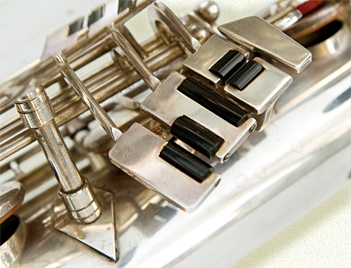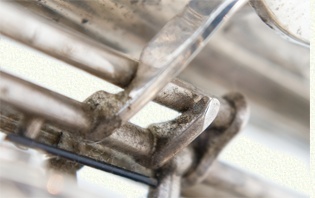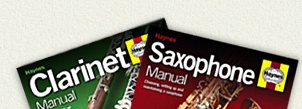Lafleur (B&S Weltklang) GDR baritone saxophone
 Origin:
East Germany Origin:
East Germany
Guide price: £300 for an old banger..to considerably more
for a pristine example
Weight: Heavy!
Date of manufacture: 1970s
Date reviewed: February 2011
A budget baritone from the Eastern Bloc
Back when I were a lad there were three options available if you
wanted to play a baritone sax; a top-of-the-range Selmer MKVI, priced
at squillions of pennies; a secondhand vintage American model, without
a low A and with often very squishy keywork - or one of these, the
East German 'cheapo' bari.
There were a LOT of these about, mostly because of the price of
the Selmer and the limitations of vintage models - and because they
got the job done at a price that didn't break the bank.
They appeared under a variety of names - the Lafleur (as this one
is), the Weltklang (the most common) and the B&M Champion. Under
the Weltklang name this horn was called 'The Soloist' - there's
a slightly cheaper model that's simply badged 'Weltklang'.
As if that isn't confusing enough, there's more than one kind of
Lafleur. It's just a brand name, and got stamped on whatever the
retailer bought in...so you could see the same name stamped on a
Czechoslovakian-built horn.
It may surprise you to know that these horns were built by B&S
- who subsequently went on to build such horns as the Medusa, the
2001 and the
Guardala;
quite expensive horns. This explains why some people seem to hold
these baritones in quite high regard.
The factory produced most of the entire range of saxes under the
Weltklang banner - their sopranos were bloody awful, their altos
were iffy, their tenors were so-so...but their baritone was about
the most successful of the bunch in terms of tone, tuning and build
quality. This is largely due to larger instruments being rather
more forgiving of small manufacturing issues as opposed to any effort
on the manufacturer's part to excel at building baritones.
Nonetheless they were of basic but functional quality (catering
quality, as I call it) - and for a very long time, at least until
the advent of Japanese horns, there wasn't much else out there on
the market. The death knell finally sounded for them in the 1980s
when the Taiwanese entered the market and the Jupiter usurped the
East German model as the budget bari of choice.
It's perhaps a credit to the manufacturers that many Weltklang
baritones are still in use today, even with the advent of brand
new Chinese baritones at sub-£1000 prices a used Weltklang
is still an attractive option for a bari player on a tight budget
provided one can be found at the right price.
It's worth keeping in mind that earlier models (some even had rolled
tone holes) were reputed to be of better quality...though even then
there's general agreement that the quality was variable.
The photo gives an indication of how this model was developed -
note the ring above the low A key cup. It's a fair bet that the
body tube down to the ring above the low C# tone hole was exactly
the same as the earlier model that only went down to low Bb. By
making a new section that housed the low B, Bb and A tone holes,
then attaching a section of the bell from the Bb model, a low A
variant could be produced quite cheaply. The method of manufacturing
wasn't uncommon at the time, when the low A was beginning to become
a popular feature. The only other addition would be the necessary
keywork - which is simple enough.
The construction is pretty basic, with no frills; there's no detachable
bell or upper bow joint (so if you drop the horn and bend it, it
will require the body to be unsoldered in order to gain access to
the bore); there's very little bracing, particularly around the
upper bow - and the bell brace will drive itself into the body in
the event of a bell-on fall; and the static thumb rest is more of
an afterthought than a precisely angled ergonomic support.
The lack of sufficient bracing on the upper bow often means that
crook socket downpipe is subjected to a lot of stress - especially
when the mouthpiece is being pushed onto the crook cork. This leads
to bending of the tube, which in turn throws the octave key mechanism
out of line. This is a major problem, as the octave mech has no
leeway designed into it at all - one part slightly out of line and
the pads simply won't seal. When clients bring these horns in complaining
of recently developed response problems, this mechanism is the first
thing I look at.
The pillars and fittings are soldered on with varying quality; the
guard feet in particular are very prone to dropping off and disappearing
- so much so that I have a template for making new ones out of sheet
brass, and the owner of this baritone has found that it's wise to
keep a tube of superglue in the case as there's no telling when
a pillar might suddenly fall off for no apparent reason at all.
A very common problem with these East German horns is warped tone
holes. This, fortunately, is easy to correct - if a tad expensive
- due to the plain tone holes. It's a very different matter on those
models with rolled tone holes.
It's this issue that's given these horns such a poor reputation
down the years, so if you're thinking of buying one it's wise to
factor in the potential cost of having them sorted out - though
because they've been around for a good few years now there's every
chance that this work may have already been done. Check for original
pads (see below) - if fitted it may indicate that the horn has not
been overhauled.
The finish isn't too bad on the whole. This example looks a bit
grimy, but underneath all the muck the plating's in quite good condition.
Lacquered models tend to wear rather more, but it's by no means
a big problem.
 The
keywork complements the basic design of the body - you very clearly
get what you pay for. The
keywork complements the basic design of the body - you very clearly
get what you pay for.
It's crude in places, quite 'blocky' in design - but reasonably
tough nonetheless. There's quite a lot of 'spring' in the keywork,
which can be something of a problem once the keys get to a certain
size. This leads to a rather squishy feel under the fingers...the
keys continue to flex for some way after the pressed key has done
its work (either opening or closing a pad, for example). On the
plus side, if you knock the keywork it's quite likely that it will
simply bounce back into place.
As per the body there are few refinements. There are no adjusters
on the stack keys, and this in itself isn't that much of a big deal
- but on some East German models they used strips of red rubber
instead of cork for the key buffers. If you've never experienced
the feel this gives to the action then I suppose the best description
I can give is that it's like trying to play a mattress. This again
is something to watch out for when purchasing - a complete recork
is the only viable fix.
The aforementioned rather clunky octave key mechanism that tends
to leak unless it's set 'just so' is perhaps the Achilles heel of
these baritones. There's no place for the soft, comfortable and
quiet feel of felt here (like that fitted to the octave key touchpiece
shown on the left)...if there's even a fraction of give in the corks
it will be multiplied by the flex in the keywork and the whole thing
will simply leak. Good, hard cork is what's needed. It makes the
mechanism feel a bit lumpen, but it's the only way to ensure it
works properly.
This theme carries over to the low A mechanism. The flex in the
keywork is amplified by the length of the keys.
This - coupled with a very likely warped tone hole and an extraordinarily
squishy pad (which we'll get on to shortly) - means that it's nothing
short of a miracle that anyone can hit a low A on one of these horns.
 But,
the Lafluer has a little trick up its sleeve! But,
the Lafluer has a little trick up its sleeve!
Not only do you get a low A thumb key, you also get an extra spatula
key on the left hand table.
OK, granted, this key is just as flexible as all the others - but
between it and the thumb key it gets the job done...and then some.
I reckon if you placed a Brazil nut between the low A key cup and
the tone hole, the combined closing force of these two keys would
pop the shell off in an instant.
It all rather sounds like a workaround for a poorly built thumb
key, but in use I found this additional table key to be a real boon.
It opens up a number of additional fingering possibilities...but
more than that it just feels so natural to slide your finger down
off the Bb spatula to get a low A. After half an hour of playing
this horn and then reverting to my own bari (which only has a thumb
key), I found myself reaching for a non-existent table key.
Note though how blocky the spatula keys are - they're practically
a homage to Picasso.
Note too that very crude bell brace - if you look closely at the
lower mount you can see where a knock to the bell has pushed it
into the body. This will explain why sharp-eyed readers might have
noticed that in the main shot the baritone seems to be leaning slightly
forward around the top stack. That's because it is.
Due to the cost of dismantling a baritone without detachable sections,
players often settle for having them set up so that they work 'around
the bend'.
To be fair, they have tried to make some concessions to the flex
in the keywork - it's just that they didn't try very hard.
This is the additional regulation link between the low Bb key and
the low B, which acts in tandem with the tab that usually hangs
off the bottom of the low B spatula - the idea being to give the
low Bb key a little bit of a boost when it comes to closing the
low B pad.
 The
trouble is it's so very small indeed - and the keys so large - that
the leverage required to make it work would probably end up in the
keys bending. The
trouble is it's so very small indeed - and the keys so large - that
the leverage required to make it work would probably end up in the
keys bending.
In fact all it really seems to do is hold off the low B pad - and
as such it's about the most pointless design I think I've ever seen.
Finally, the key pearls are cheap, dished plastic - which does
nothing to help the feel of the action.
On the plus side though, proper point screws are used - so that
although the action flexes with gay abandon, you can at least ensure
it won't wobble. Always nice to have a bonus.
Just a quick note regarding the springs. As originally fitted they're
not quite blued steel but neither are they those awful cheap stainless
ones. They're actually not that bad, to be honest, and they seem
to be as tough as the proverbial old boots. If they're in good condition,
leave them well alone - they'll do just fine.
I mentioned the pads earlier, and this is something of a curiosity
on East German horns.
They're incredibly springy, due to their having no backing card.
When fitted, the glue that holds them in the key cups only grips
the pad by the outer edge - leaving the felt core free to move up
and down. This is curious enough in itself but there's also a metal
ring fitted inside the pad, over which the leather sits. The upshot
of all this is that the pads tend to 'hang' from the sides of the
key cups, with very little support beneath them. If you press down
on the centre of the pad it sinks into the key cup and then pops
up again...quite literally sometimes, as the flat reflector acts
like one of those little metal clicky toys.
Added to all this is the quality of the leather itself - we're back
to the proverbial old boots again, which is probably where they
got the leather from.
So - this all sounds appalling...but perhaps not...because they
practically last forever.
I've repaired Weltklangs that are over forty years old...and still
on the same set of pads. If the tone holes are made level, the key
cups correctly angled and proper corks and felts used in place of
the original rubber buffers, these funny old pads will just about
do the business. Sure, you won't get an absolutely perfect seal,
nor will the keys close with satisfying certainty - but hey, we've
all played worse!
Speaking of which - how does it play?
Nowhere near as badly as you might think (from all my previous comments).
Yes, the action feels a bit clumsy and imprecise - but then it's
a cheap baritone, and to some extent you can get away with it. It's
not too uncomfortable under the fingers - the keys are reasonably
well placed, though the bell key table isn't all that nimble in
practice.
This particular horn has had the awful rubber buffers changed and
a number of pads swapped out - so in places it felt reasonably firm,
and with a bit of modding you can make substantial improvements
to the feel.
Tonewise it's a bit of a honker. It's not that it's incapable of
finesse, it's just that it has a tendency to add a little bit of
buzziness to each and every note. In its defence I'll say that you
get used to it quite quickly, but it soon becomes clear that this
baritone is far more comfortable when it's being blown hard.
This is, essentially, what it was designed for - for so many years
it was the staple fare of horn section players who couldn't run
to a Selmer and who needed a low A...and in that respect it does
the job admirably.
I can't in all honesty say that the tone is even across the range,
it tends to get a bit dry the further up the scale you go. With
some care and practice, and the right mouthpiece, you could smooth
things out quite considerably, but this horn's forte lies in pumping
out the low notes with gritty determination.
The tuning's not too bad...perhaps a touch wild at the top, but
nothing that couldn't be brought into line with time spent getting
used to the horn's foibles.
One thing to note is that the mouthpiece supplied with these horns
was utterly dreadful, which again probably didn't help the horn's
reputation.
In spite of my harsh words I do have a soft spot for these old
troopers - in fact I've done many a gig on this horn in particular,
having depped for the owner a number of times without having a baritone
of my own.
Providing you're aware of its limitations, and are prepared to take
the bull by the horns, you can do quite a lot with an East German
bari.
However, there's the issue of the competition these days - and it's
quite strong. A modern Ultra-Cheap Chinese baritone will be based
on either a Selmer, Yamaha or Yanagisawa design, and in that sense
it's already streets ahead ergonomically. It's also a great deal
tougher, having better braces and rather stiffer keywork. The pads
might not be of top quality, but they're far firmer - and the whole
thing adds up to a much more presentable package...and at a price
that won't make you cough (much).
The price of a GDR bari can be quite variable though- I've seen
these horns selling for quite a lot of money, which is surprising
given the build quality and the so-so tone...but you can sometimes
find them going for a great deal less. The owner of this bari paid
but a few hundred pounds for it. I think if you bought one of these
because you'd read some glowing reports about them but had never
previously played one yourself, you might end up being quite disappointed
- it all depends what you paid for it, I suppose.
Having done battle on the workbench with hundreds of Weltklangs
I suppose I should be quite glad to see the back of them, but from
a personal perspective I have a little fondness for this rough and
ready horn that just keeps going no matter what.
It's the Monty
Python Black Knight of saxophones...
|



